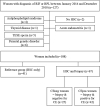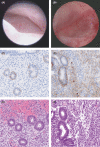Treatment following hysteroscopy and endometrial diagnostic biopsy increases the chance for live birth in women with chronic endometritis
- PMID: 34218478
- PMCID: PMC8596418
- DOI: 10.1111/aji.13482
Treatment following hysteroscopy and endometrial diagnostic biopsy increases the chance for live birth in women with chronic endometritis
Abstract
Problem: Repeated implantation failure and recurrent pregnancy loss are associated with chronic endometritis, a persistent endometrial inflammation. Its diagnosis and treatment may increase pregnancy and live birth rates. The aim of this study was to assess the effectiveness of endometrial diagnostic biopsy and subsequent antibiotic treatment in cases of chronic endometritis on reproductive outcomes over a long observation period.
Method of study: We conducted a historical cohort study (2014-2018) at our University-based infertility center that included women (n = 108) with repeated implantation failure or recurrent pregnancy loss without known pathologies associated with either condition. Forty-one women underwent a hysteroscopy only (reference group); the remaining 67 women underwent, in addition to the hysteroscopy, an endometrial diagnostic biopsy with immunohistochemically staining for CD138 to detect plasma cells (biopsy group). If one or more plasma cells were detected, the women were treated with doxycycline 100 mg twice a day orally for 2 weeks. We performed stratified survival analysis (Kaplan-Meier) and Cox regression.
Results: The biopsy group had higher chances of pregnancy (hazard ratio 2.28; 95% confidence interval 1.23-4.24; p = .009) and of live birth (hazard ratio 2.76; 95% confidence interval 1.30-5.87; p = .008) compared with the reference group. In the sensitivity analysis, repeated implantation failure or recurrent pregnancy loss did not affect the outcome.
Conclusion: Endometrial diagnostic biopsy followed by antibiotic treatment in case of chronic endometritis in women with repeated implantation failure or recurrent pregnancy loss may increase the chances for live birth.
Keywords: chronic endometritis; endometrial diagnostic biopsy; plasma cells; recurrent pregnancy loss; repeated implantation failure; time to live birth; time to pregnancy.
© 2021 The Authors. American Journal of Reproductive Immunology published by John Wiley & Sons Ltd.
Conflict of interest statement
The authors report no conflicts of interest.
Figures



Similar articles
-
Prevalence of chronic endometritis in repeated unexplained implantation failure and the IVF success rate after antibiotic therapy.Hum Reprod. 2015 Feb;30(2):323-30. doi: 10.1093/humrep/deu292. Epub 2014 Nov 10. Hum Reprod. 2015. PMID: 25385744
-
Chronic endometritis in women with recurrent pregnancy loss and recurrent implantation failure: prevalence and role of office hysteroscopy and immunohistochemistry in diagnosis.Fertil Steril. 2016 Jan;105(1):106-10. doi: 10.1016/j.fertnstert.2015.09.025. Epub 2015 Oct 9. Fertil Steril. 2016. PMID: 26456229
-
Antibiotics improve reproductive outcomes after frozen-thaw embryo transfer for chronic endometritis treatment, especially in those with repeated implantation failure.BMC Womens Health. 2024 Jul 27;24(1):430. doi: 10.1186/s12905-024-03274-x. BMC Womens Health. 2024. PMID: 39068427 Free PMC article.
-
Effects of chronic endometritis therapy on in vitro fertilization outcome in women with repeated implantation failure: a systematic review and meta-analysis.Fertil Steril. 2018 Jul 1;110(1):103-112.e1. doi: 10.1016/j.fertnstert.2018.03.017. Epub 2018 Jun 13. Fertil Steril. 2018. PMID: 29908776
-
Quantifying CD138+ cells in the endometrium to assess chronic endometritis in women at risk of recurrent pregnancy loss: A prospective cohort study and rapid review.J Obstet Gynaecol Res. 2021 Feb;47(2):689-697. doi: 10.1111/jog.14585. Epub 2020 Dec 3. J Obstet Gynaecol Res. 2021. PMID: 33274569 Review.
Cited by
-
Performance of hysteroscopy in diagnosing chronic endometritis and the role of intra- and inter-observer variability: a prospective study of 70 cases.AJOG Glob Rep. 2025 May 22;5(3):100515. doi: 10.1016/j.xagr.2025.100515. eCollection 2025 Aug. AJOG Glob Rep. 2025. PMID: 40607240 Free PMC article.
-
Chronic endometritis and assisted reproduction: a systematic review and meta-analysis.Rev Assoc Med Bras (1992). 2023 Oct 13;69(10):e20230792. doi: 10.1590/1806-9282.20230792. eCollection 2023. Rev Assoc Med Bras (1992). 2023. PMID: 37851720 Free PMC article. No abstract available.
-
"Shortening time to pregnancy in infertile women by personalizing treatment of microbial imbalance through Emma & Alice: A multicenter prospective study".Reprod Med Biol. 2025 Feb 1;24(1):e12634. doi: 10.1002/rmb2.12634. eCollection 2025 Jan-Dec. Reprod Med Biol. 2025. PMID: 39896099 Free PMC article.
-
Comparing the accuracy of Pipelle versus hysteroscopy and curettage in the diagnosis of chronic endometritis in women with recurrent implantation failure: A prospective cross-sectional study.PLoS One. 2025 Mar 21;20(3):e0319294. doi: 10.1371/journal.pone.0319294. eCollection 2025. PLoS One. 2025. PMID: 40117251 Free PMC article.
-
Risk factors of chronic endometritis in women who have undergone hysteroscopy: a prospective nested case-control study.Sci Rep. 2024 Aug 5;14(1):18099. doi: 10.1038/s41598-024-69095-y. Sci Rep. 2024. PMID: 39103391 Free PMC article.
References
Publication types
MeSH terms
Substances
LinkOut - more resources
Full Text Sources
Medical
Research Materials

